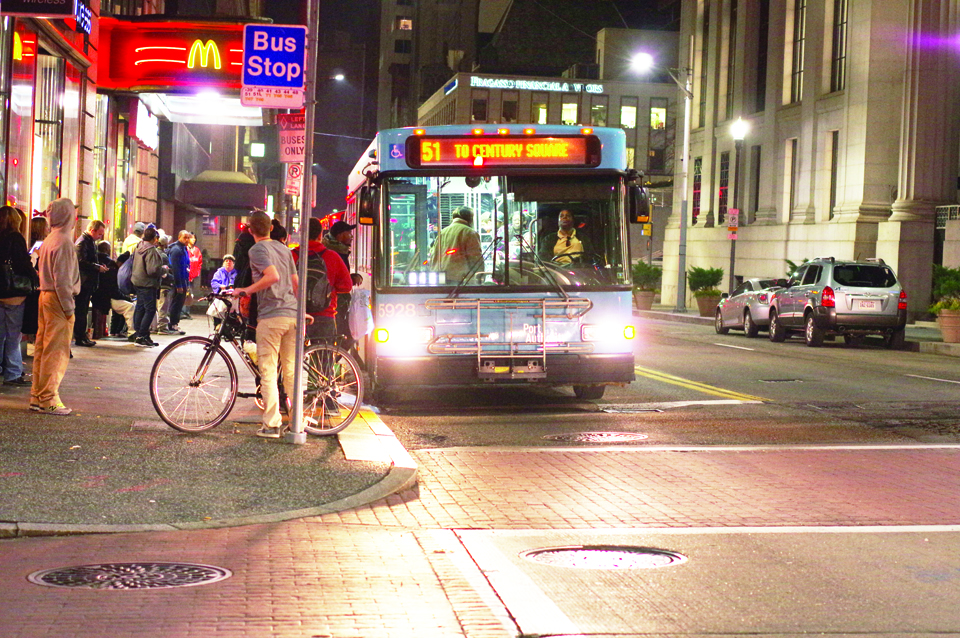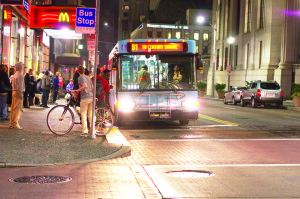

By Brittney Jackson | The Duquesne Duke
Mayor-elect Bill Peduto is supporting a plan to institute a Bus Rapid Transit system that will connect Downtown Pittsburgh to the heart of Oakland.
According to Allegheny County Executive Rich Fitzgerald, the idea to link the two areas has been in discussion for over two decades. Downtown and Oakland, the second and third largest job centers in the state of Pennsylvania respectively, are consequently the most traffic congested areas of Pittsburgh.
Fitzgerald said the congested commute between two of the state’s largest job centers results in excessive driving and parking problems, which hurts businesses. The idea for the BRT came from a similar system in Cleveland.
Fitzgerald said the BRT would be a “train on rubber wheels” that would be reliable and fairly quick.
“If you make [the BRT system] reliable and fast, people will use it,” Fitzgerald said.
Unlike a bus, the BRT would not stop multiple times. Instead, Fitzgerald said the BRT would have major stations where people board and leave. The system would include dedicated bus lanes and traffic lights that would ensure an approximate nine minute travel time between Downtown and Oakland.
Fitzgerald said one of the perks would be increased development along the corridor that the BRT travels along. The areas surrounding the BRT in Cleveland experienced huge development in blighted areas, according to Fitzgerald. Fitzgerald also said there will be more investment in the areas between Downtown and Oakland.
District 5 Councilman Corey O’Connor said he noticed a spark in economic development around every BRT stop in Cleveland.
“You saw apartment buildings going up, commercial real estate and art; all things that spurred from transit stops,” O’Connor said.
The cost of the project is expected to be approximately $200 million, Fitzgerald said, and will cover the construction of dedicated lanes and signaling and the purchase of the train cars.
The funding will come from a variety of sources. Fitzgerald said that a grant from the federal government, if secured, is expected to cover approximately 50 percent of the cost. To obtain funding, a plan for the BRT must be submitted to the Federal Transportation Administration for approval.
Other sources would include state money and local finances, according to Fitzgerald. The expected construction time for the BRT is two to three years. If the project plan stays on track, the BRT would be completed by 2017.
Senior economics major Andrew Bryk, whose thesis compares the effectiveness of funding from different levels of government for public transportation, said he is “cautiously supportive” of the BRT system. Bryk said that BRT systems are effective because they have all the features of a train for a much less expensive price.
“Of the options that the city has for expanding mass transit, the BRT is the lowest risk and the most cost effective solution,” Bryk said.
However, some crucial steps should be taken before a BRT system in Pittsburgh can be considered feasible, according to county spokeswoman Amie Downs. An environmental impact study or survey of Pittsburgh residents’ opinions on a BRT system have yet to be completed. Without this data, the concrete benefits of a BRT system have yet to be determined.
Assistant professor of quantitative sciences Charles Wilf, who has a doctorate in public policy analysis, said the intent to have fewer stops to cut down travel times is a good idea if it is economically feasible.
“If this could be done financially feasible, it would be a good idea,” Wilf said. “I think it could also stimulate development in the corridor based on what we’ve seen in Cleveland.”



